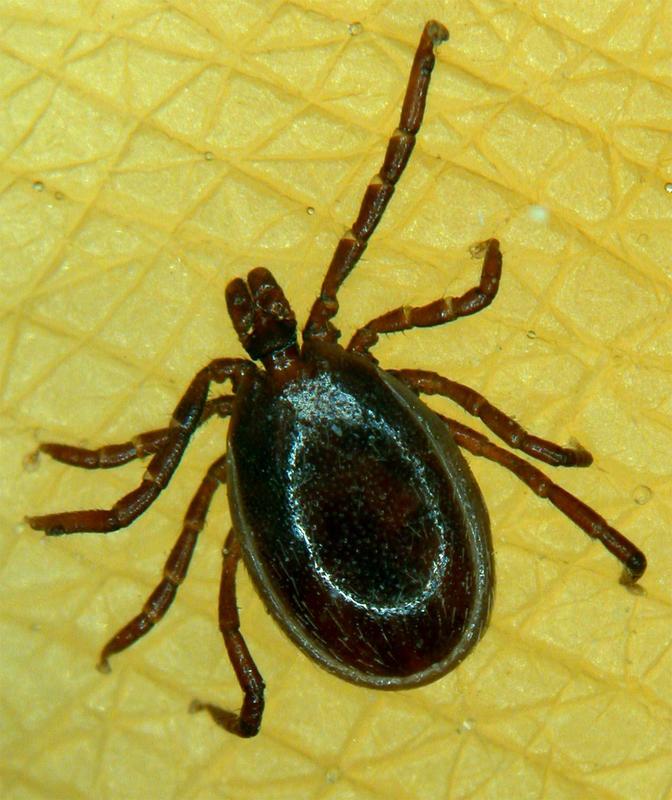How ticks get a proper foothold

A male tick Ixodes ricinus attached to a resin replica of human volar skin by seven of eight feet, while the translucent adhesive pad and claw of the right foreleg is folded back upwards and the foot joint contacts the substrate. Copyright: Dagmar Voigt
Ticks spend more than 90 percent of their up to three-year-long life starving and clambering around in leaf litter and on vegetation. They walk remarkable distances while periodically exploring distal plant parts in order to prey on their victims. Once they get to humans and animals, the little parasites walk along skin and hairs, searching for suitable feeding sites.
160 years after a first note by Hermann Burmeister about the ticks' feet composition of paired, curved, tapered tarsal claws and between them a pad, the current morphological details and adhesion experiments led to new deductions on the function of ticks' feet.
“The fact that not only the pad, but also the transparent claws contain the elastic protein resilin is surprising, because we have never observed resilin in arthropod claws before,” said Dagmar Voigt from the Institute for Botany of Technische Universität Dresden. With these sticky pads, ticks are able to attach easily to smooth surfaces like human skin and glass.
Depending on the situation and required power, the pads can be folded and unfolded – similar to an accordion. An adhesion-mediated fluid adds to the adhesion of the pad. While walking in litter or on contaminated surfaces, ticks frequently fold back their feet and run on their tarsal-tibial joint.
Males are rather small and access the host body for copulation purposes only. Thus, their feet are smaller and attach less than females. On glass, females generate forces corresponding to more than 500-fold of their own body weight in order to ensure their safety.
During blood sucking, the female body weight can increase up to 135 times. Voigt and Gorb also showed that the attachment was worse on skin silicon replicas and on micro-rough resin surfaces. “As to attachment, ticks are almost generalists due to the combination of their soft adhesive pads and tapered claws; but not entirely.
Our experiments clearly show, how a future technical surface, having anti-adhesive properties for ticks, could look like,” summarised Stanislav Gorb from the Zoological Institute of Kiel University. Thus, ticks could be prevented from attaching to skin and hair.
###
Movie of female ticks walking on a glass ceiling: http://movie.
Media inquiries:
Dr Dagmar Voigt
Technische Universität Dresden
Phone: +49 351 463 35834
Email: dagmar.voigt@tu-dresden.de
Prof. Stanislav N. Gorb
Kiel University
Phone: +49 431880 4513
E-mail: sgorb@zoologie.uni-kiel.de
Media Contact
All latest news from the category: Life Sciences and Chemistry
Articles and reports from the Life Sciences and chemistry area deal with applied and basic research into modern biology, chemistry and human medicine.
Valuable information can be found on a range of life sciences fields including bacteriology, biochemistry, bionics, bioinformatics, biophysics, biotechnology, genetics, geobotany, human biology, marine biology, microbiology, molecular biology, cellular biology, zoology, bioinorganic chemistry, microchemistry and environmental chemistry.
Newest articles

High-energy-density aqueous battery based on halogen multi-electron transfer
Traditional non-aqueous lithium-ion batteries have a high energy density, but their safety is compromised due to the flammable organic electrolytes they utilize. Aqueous batteries use water as the solvent for…

First-ever combined heart pump and pig kidney transplant
…gives new hope to patient with terminal illness. Surgeons at NYU Langone Health performed the first-ever combined mechanical heart pump and gene-edited pig kidney transplant surgery in a 54-year-old woman…

Biophysics: Testing how well biomarkers work
LMU researchers have developed a method to determine how reliably target proteins can be labeled using super-resolution fluorescence microscopy. Modern microscopy techniques make it possible to examine the inner workings…





















